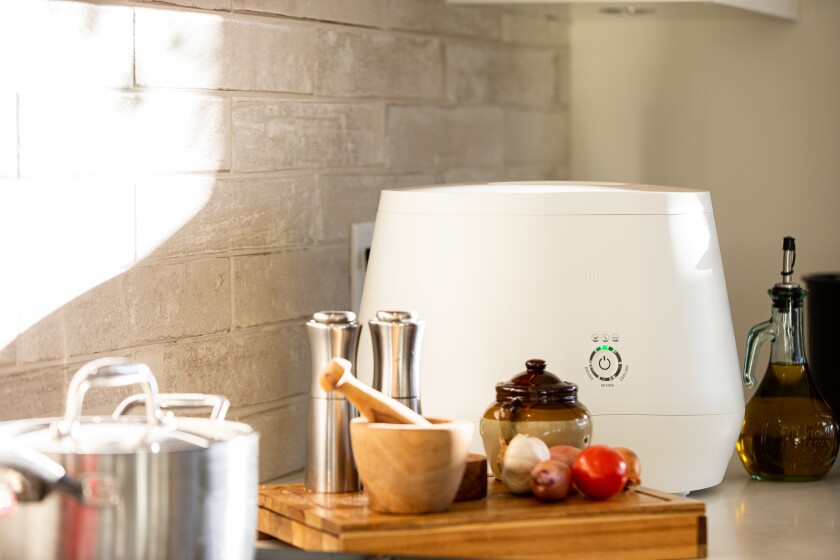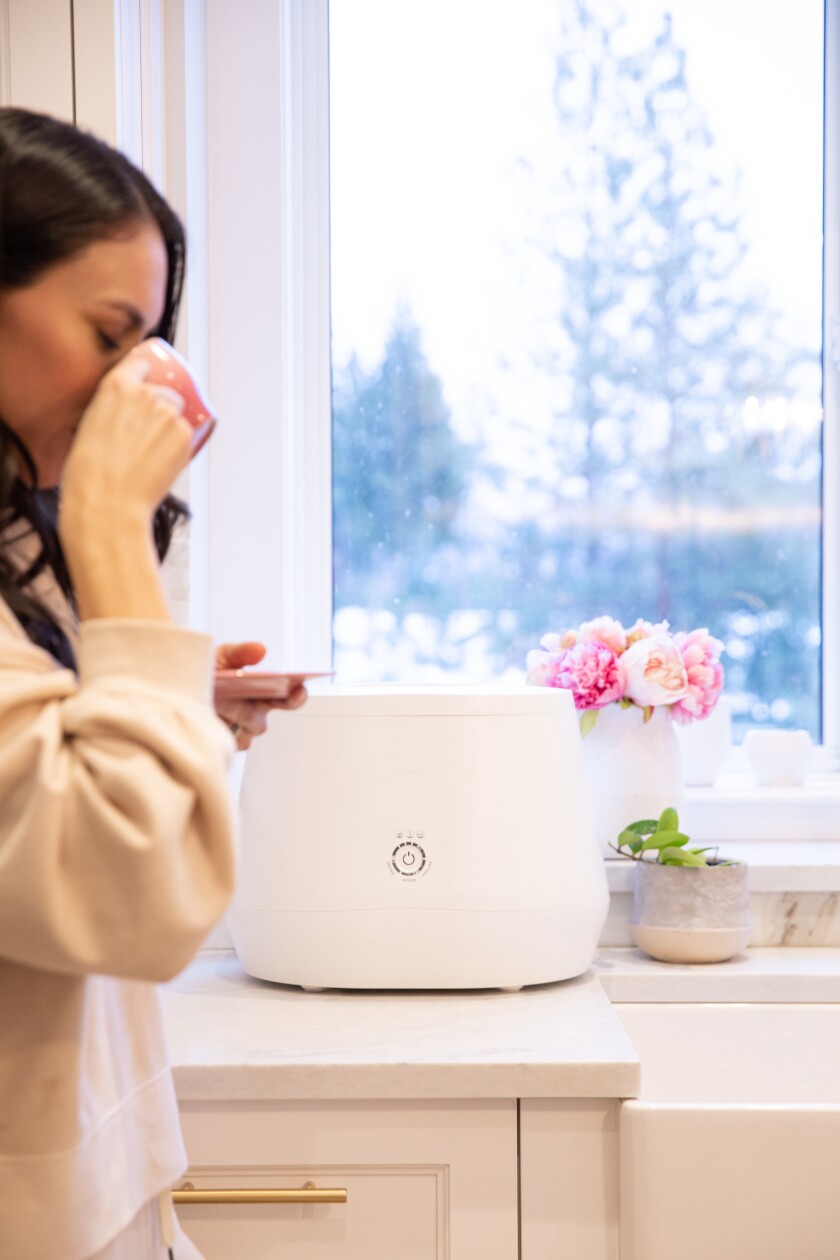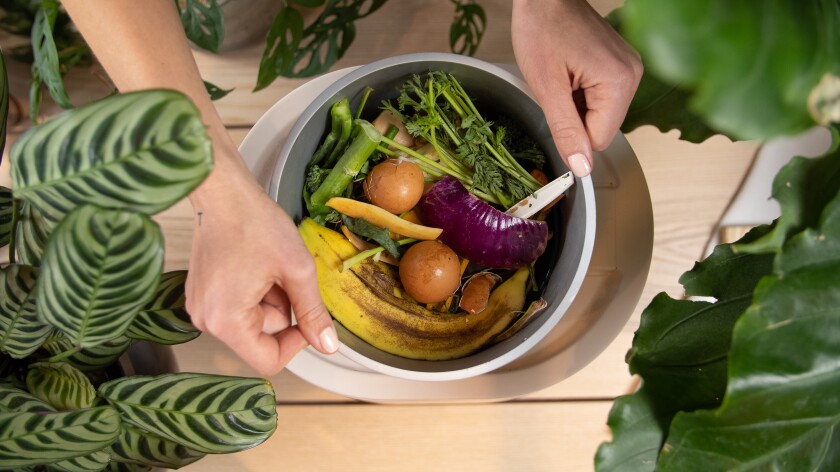Imagine being able to turn food scraps into soil in a matter of hours right in the kitchen.
With technology, it’s currently possible to do just that.
Recently in Tech Savvy, we noted the number of options out there to keep the garden going for fresh vegetables and herbs into the winter with a host of indoor gardens. Those gardens can be small enough to be on the counter and serve one person or large enough to serve several families and be incorporated into small living spaces.
So whether gardening indoors this winter or just as a consumer looking to eat healthy, there can be something else people miss with winter — a fully functional compost bin.
Outdoor composting through the winter, even in harsh climates like Minnesota, is totally doable with just a little more work — like chopping down food scraps into smaller pieces or insulating the compost bin.
“Fortunately, it is absolutely possible to continue successfully composting during the winter,” the University of New Hampshire Extension Service noted. “You can even start composting for the first time in the winter. While the decomposition process slows down once the temperature drops, it doesn’t totally stop, or at least not for long. … The only time decomposition comes to a stop is when the materials in a compost pile are completely frozen.”
Recommendations for successful winter composting outside come in continuing to use a mix of brown and green — brown for carbon-rich items such as leaves, newspaper, dryer lint, straw, wood branches and nitrogen-rich green items such as food scraps, coffee grounds , egg shells, grass clippings, and plant trimmings — with about three to four parts brown material and one part green, according to multiple sources or equal amounts of brown and green from another.
Every fall, I gathered a large bag of leaves and set it aside in the garage to use as layers in the outdoor compost bin. I continued to layer in the green to the brown, but, of course, not a lot of actual composting happens for a shaded bin in deep winter. By spring, when you can turn the contents, you still have a mix that needs more time to break down.
My mom always kept her food scraps for my compost in a container under the sink. Recently, I discovered there are actual compost containers for that to make sure the scraps don’t become a stinky mess. But that becomes one of the drawbacks and one of the reasons people don’t do it or end up tossing out the mess. I know some folks keep their food scraps in the fridge to control that issue, but again the smell and space used can become an issue.
But there is also a bit of technology that can help and create something to add to the compost bin that is much further along in the process and keeps food waste out of landfills.

Contributed / Lomi by Pela
The US Department of Agriculture estimates food waste in the nation is between 30-40% of the food supply.
“This estimate, based on estimates from USDA’s Economic Research Service of 31 percent food loss at the retail and consumer levels, corresponded to approximately 133 billion pounds and $161 billion worth of food in 2010. …
“In 2015, the USDA joined with the US Environmental Protection Agency to set a goal to cut our nation’s food waste by 50 percent by the year 2030.”
Composting made simple and indoors
Cutting waste by not buying more than you’ll be able to consume in a timely fashion is also a worthy goal, but even when doing that correctly, there are food scraps that can go to a compost pile to be useful without going to the local landfill and adding to methane gases.
Maybe there isn’t space or the right place for a compost bin in the yard or getting a jump start on the process will make for a better outcome. The kitchen composter serves that purpose. In July, CNET reported 28% of Americans compost food waste but 67% who don’t said they would if it was more convenient.
CNET’s reporter used Lomi, a $499 kitchen countertop composter from Pela, for a couple of weeks and reported it did the job without odor, was easy and he was able to have fun with it as well.
“In as little as three hours, Lomi transforms organic waste into practically odor-free dirt,” CNET reported. “In 16 to 20 hours, it produces rich fertilizer that can be used for potting plants or nourishing a garden.”

Contributed / Lomi by Pela
CNET noted that running the energy-efficient Lomi costs the average US household 14 cents per use. There are three settings to run from 3-5 hours to 16-20 hours depending on the desired outcome, dirt that can go to a yard compost bin to finish or in the trash without attracting animals or, the longer run time, which creates dirt that is ready for use in potted plants or gardens.
Added benefits of using the indoor composter to speed the process come in compost material without a smell that attracts bugs or animals because the output looks like shredded leaves or soil, depending on the setting. Reviews said the composter sounded like a dishwasher when in use. A review in bon appetit compared the sound to a coffee pot or microwave, there but not disruptive.
Lomi is 16 inches wide by 12 inches in height, and 13 inches deep and weighs 22 pounds. It doesn’t have to be used in the kitchen, but of course the way to use it frequently is to keep it convenient and close to where the food scraps are created. Scraps can go in and remain in the container for days before the composter is put into action, keeping any smell sealed inside, according to multiple reviews.
“Compared to throwing your waste in the landfill, using Lomi reduces the carbon footprint of your food waste by 65%,” the company reported.

Contributed / Lomi by Pela
The Lomi includes a LomiPod (that speeds up the process and adds nutrients to the end product) and activated carbon refills. The Lomi starter package includes 45 cycles of filters and pods for nearly $500 or an essentials package with one Lomi and a year subscription of filters, which is billed and shipped every three months. It has a 30-day return policy with free shipping and a full refund.
Lomi reports 80% of waste can go into the composter, including fruits and vegetables, bread and grain products, animal products, yard waste and Lomi approved products and packaging — like the box it comes in. The lowest setting uses low heat to preserve nutrients.
“It typically takes a few days for me to fill up the Lomi bin, and the smell of slowly decaying produce is unnoticeable when the lid is on thanks to those charcoal filters,” according to the bon appetit review. “… I also love the fact that I don’t have to empty my Lomi after each cycle. All the food waste that goes into the Lomi reduces into a very small amount of Lomi ‘dirt,’ so you can run up to three cycles in a row before having to empty it.”

Contributed / Lomi by Pela
Lomi isn’t the only option. The Vitamix FoodCycler reports that it composts food in 4-8 hours. The cost is one cent shy of $400.
The FoodCycler was on a short list of recommended kitchen compost machines at Wired, with Reencle Prime topping the list as a machine that can run continuously as food scraps are thrown inside. When it is done, the finished product can be scooped out to go to the garden leaving some of the mix behind.
“Some have to remain behind to provide enough bacteria to keep the process going,” Wired reported. “The device automatically warms, stirs, and occasionally dries the mix out to keep the microbes happy.” After a sale price, the full Reencle price was expected to be about $700. Wired listed the Lomi as “a good, cheaper option for most people.”
And for those who want to compost but would rather keep the scraps inside for a while during the winter before going out to the outside compost bin, there are multiple containers designed to contain rotting food smells before the mix is deposited in an outdoor bin. A downside can come in the cleaning of said containers so look for dishwasher safe options, but there are multiple small compost container bins designed for use inside for $20-$30.
Renee Richardson, managing editor, may be reached at 218-855-5852 or
. Follow on Twitter at
www.twitter.com/DispatchBizBuzz
.
.